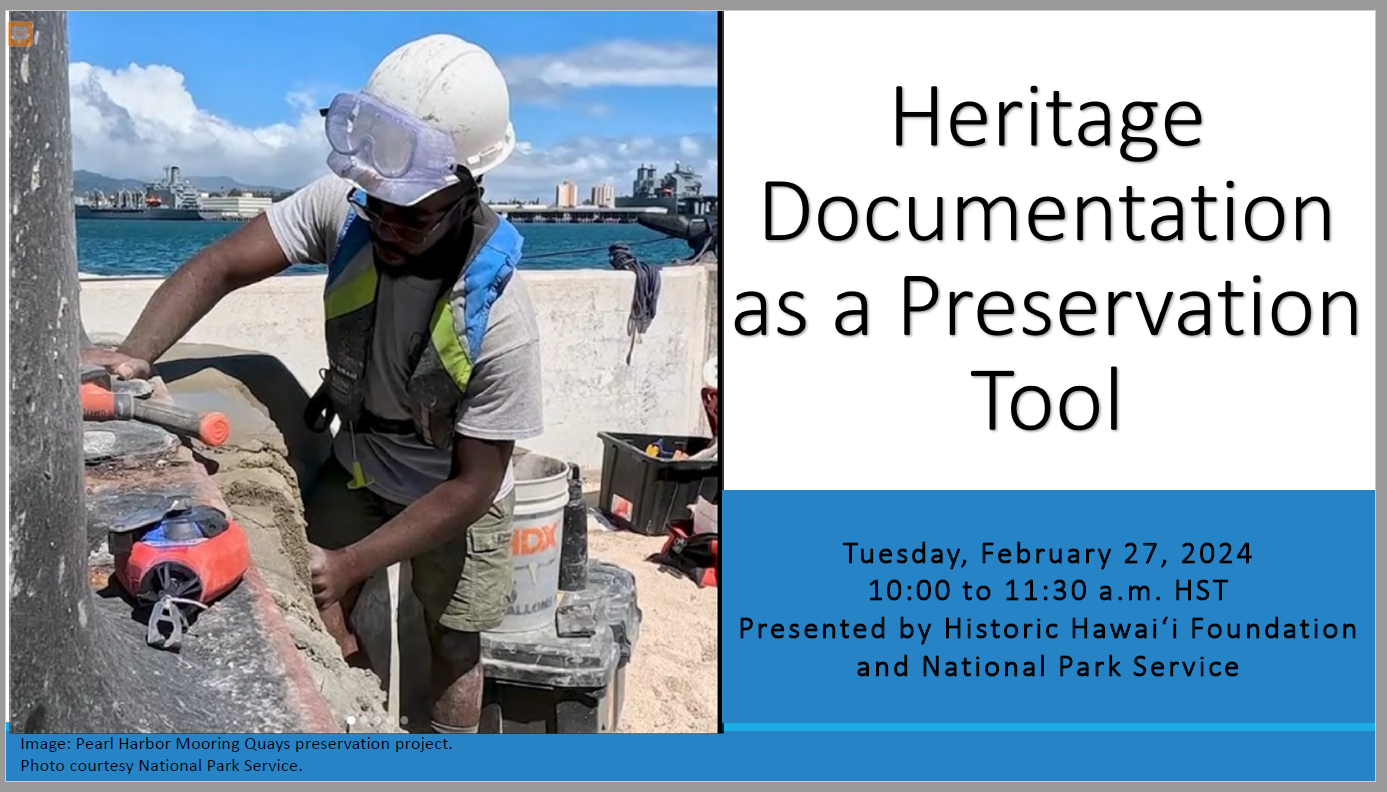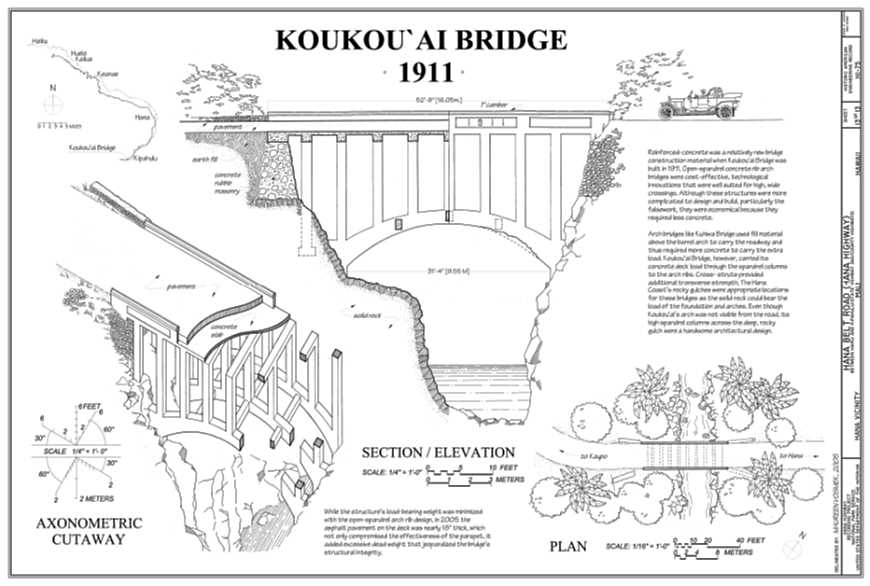
Hawai‘i Preservation in Practice Training Webinar:
Heritage Documentation as a Preservation Tool
Historic Hawai‘i Foundation, in partnership with the Department of the Interior’s National Park Service, will offer a free webinar on utilizing heritage documentation tools to preserve historic places.
Date: Tuesday, February 27, 2024
Time: 10:00 – 11:30 a.m. HST
Cost: Free
Virtual Webinar via ZOOM
VIEW THE RECORDING
Heritage documentation is “indispensable, for the purposes of identification, protection, interpretation, and physical preservation of movable objects, historic buildings, archaeological sites, and cultural landscapes…”
~Documenting the cultural heritage, 1998, Getty Information Institute, Council of Europe, edited by Robin Thornes and John Bold
The seminar provides training to members of the public, private or government sectors who own, manage, steward or are interested in preserving historic buildings, structures, objects, sites and districts.
Heritage Documentation as a Preservation Tool
Date: Tuesday, February 27, 2024
Time: 10:00 – 11:30 a.m.
This seminar has been approved for certificate maintenance credits through the American Planning Association (AICP) and the American Institute of Architects (AIA).
ABOUT THE COURSE
The webinar will present an overview of heritage documentation and its role in protecting, preserving and sharing historic and cultural resources.
Subject matter experts will present a variety of documentation tools and methods from simple to complex, and their potential uses, including Historic American Buildings Survey (HABS)/Historic American Engineering Record (HAER)/Historic American Landscapes Survey (HALS); research, mapping, laser scanning and more. Illustrative case studies of local projects will provide real life examples of heritage documentation for preservation, interpretation and access, and planning and conservation purposes.
Through the training attendees will:
• Learn the purpose and application for documenting historic properties and heritage sites;
• Receive an overview of heritage documentation programs for:
-archival;
-preservation planning;
-historic interpretation;
-public access purposes;
• View examples of documentation projects in Hawai‘i.
WHO SHOULD ATTEND?
• Public, private and nonprofit entities that own or manage historic and potentially historic properties in Hawai‘i;
• Government agencies and elected officials responsible for the protection of historic properties;
• Design professionals, including planners, architects, engineers, landscape architects, historians and architectural historians;
• Community organizations or individuals with stewardship responsibilities for historic properties;
• Other members of the public or organizations interested in preserving historic sites.
Image at top: Drawing of Koukouai Bridge from HAER No. HI-75 Hana Belt Road https://www.loc.gov/pictures/item/hi0808.sheet.00013a/resource
Further Reading & Reference Materials
Heritage Documentation Programs: Resources for Completing HABS/HAER/HALS Documentation
VIEW HERITAGE DOCUMENTATIONHeritage Documentation: Virtual Content
VIEW VIRTUAL CONTENTAbout the Historic American Buildings Survey/Historic American Engineering Record/Historic American Landscapes Survey
VIEW HABS/HAER/HALSHistoric Property Project Documentation Overview
VIEW HISTORIC PROPERTY DOCUMENTATIONAbout HABS and Hawai‘i Examples
VIEW HABS / HAWAI‘I EXAMPLES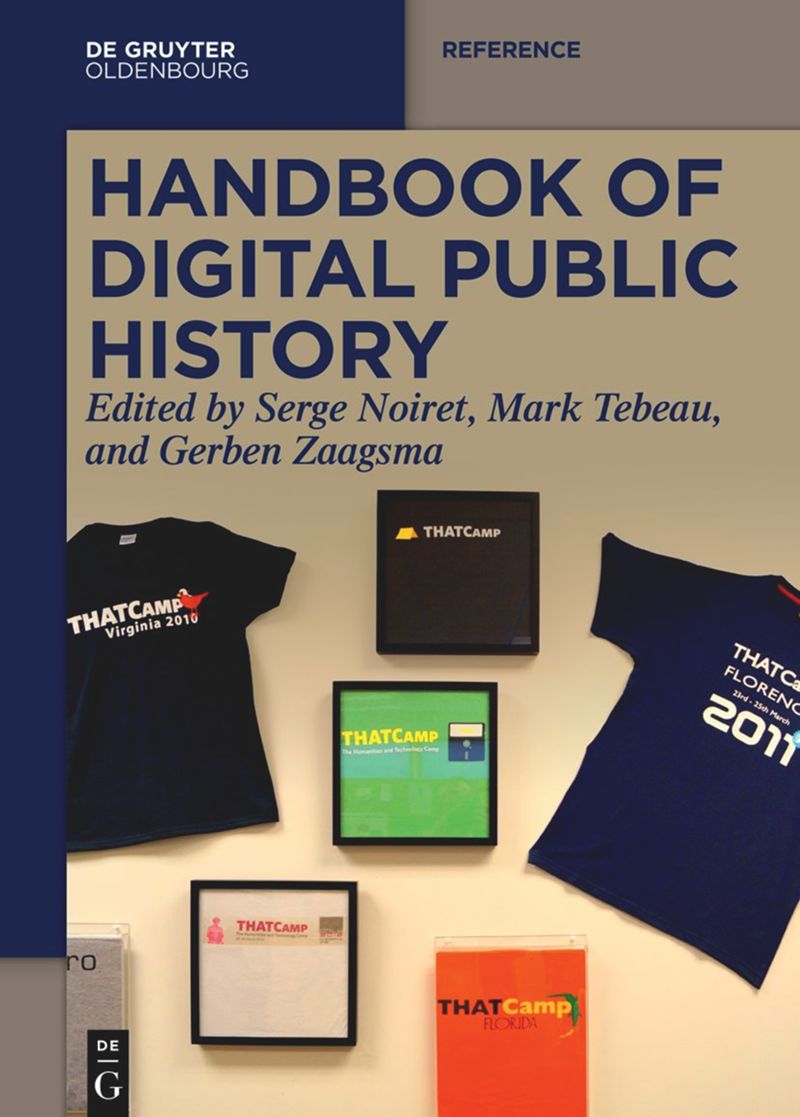
Handbook of Digital Public History, edited by: Serge Noiret , Mark Tebeau and Gerben Zaagsma.
From the essay, by Priya Chhaya and Reina Murray, “Technology and Historic Preservation: Documentation and Storytelling”:
Over the last few decades, transformation within the field of historic preservation has involved the nearly parallel tracks of expanding the histories being preserved and a constantly shifting technological landscape. This digital transformation has reshaped historic preservation practice and community engagement by making new tools and methods available for documentation and place-based storytelling. This chapter examines how technological advancements such as geographic information systems, Lidar, photogrammetry, drones, mobile applications, and social media translate data and information into a more useable and accessible format for both professional and public use.
PRESENTERS
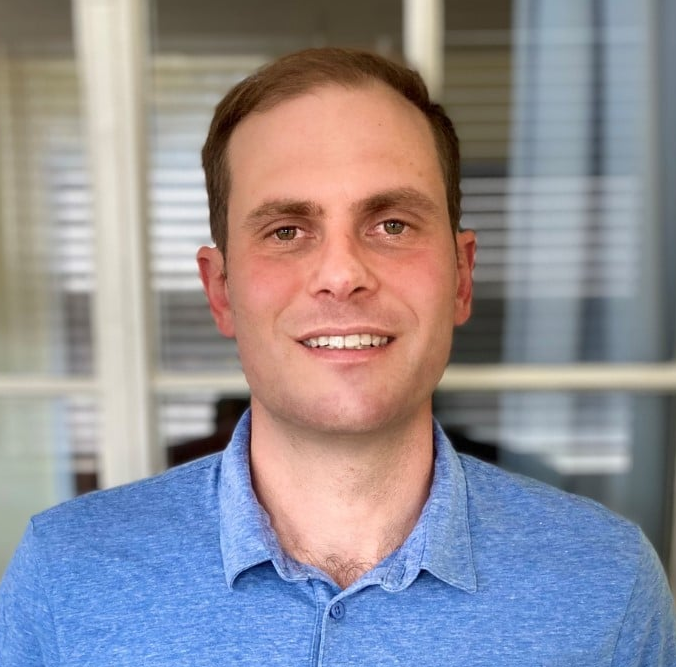
Scott Keyes is the Chief of the Heritage Documentation Programs and acting Chief of the Historic American Landscapes Survey at the National Park Service. Mr. Keyes is a Secretary of the Interior-qualified historian and architect and received his Bachelor of Arts in History from the University of California, Los Angeles and Master of Architecture from the University of Toronto. Prior to joining the National Park Service, Mr. Keyes served at the U.S. Navy as chief technical expert on historic architecture and preservation of the built environment, supporting the agency’s cultural resource program at over 70 domestic and international installations. He also previously worked as an architect at Joint Base Pearl Harbor-Hickam and as a designer at various architectural firms in Canada and the United Kingdom.

Jay Sturdevant is an archaeologist and the Integrated Resources Program Manager for Pearl Harbor National Memorial and Honouliuli National Historic site. Mr. Sturdevant previously served as an archaeologist for 22 years at the National Park Service’s Midwest Archeological Center. In addition, he has also served at the NPS Southeast Archeological Center, Dinosaur National Monument, and Knife River Indian Villages National Historic Site.
In his current role, Mr. Sturdevant oversees the preservation of the USS Arizona Memorial and shipwreck; the USS Utah Memorial and shipwreck; historic resources related to WW II and the battle of Pearl Harbor; and the archeological and cultural landscape of the Honouliuli NHS. The Honouliuli incarceration camp held Japanese American citizens and Korean, Japanese, Okinawan, German, and Italian prisoners of war between 1943-1946.
Mr. Sturdevant has a master’s degree in Anthropology from the University of Nebraska-Lincoln and a bachelor’s degree in Anthropology from Colorado State University. He is also a past President of the Plains Anthropological Society. Mr. Sturdevant was raised in Wahpeton, North Dakota.

Lilia Merrin is from Wailua, Puna, Kauaʻi. She recieved her M.A. in ʻIke Hawaiʻi (Hawaiian Studies) in 2019 and her B.A. in ʻIke Hawaiʻi and ʻŌlelo Hawaiʻi (Hawaiian Language) and in 2015 from Hawai‘inuiākea at the University of Hawai’i at Mānoa. Ms. Merrin has been working with Nohopapa Hawaiʻi for over five years as a Cultural Research Specialist, Field Assistant and Alakaʻi on various Wahi Kūpuna Stewardship (WKS, previously known as Cultural Resource Management or CRM) projects across the Pae ʻĀina from Hawaiʻi Island to Papahānaumokuākea. She specializes in Ethnohistorical Research, Writing, Community Ethnography, as well as, Web and Technical Support. Ms. Merrin also works as a Wahi Kūpuna Internship Program Instructor, Program Coordinator, and Communications Officer for the non-profit Huliauapaʻa. She is currently a Dev-Island Boot-camp student learning HTML, CSS, JavaScript, and React.js to build web applications.
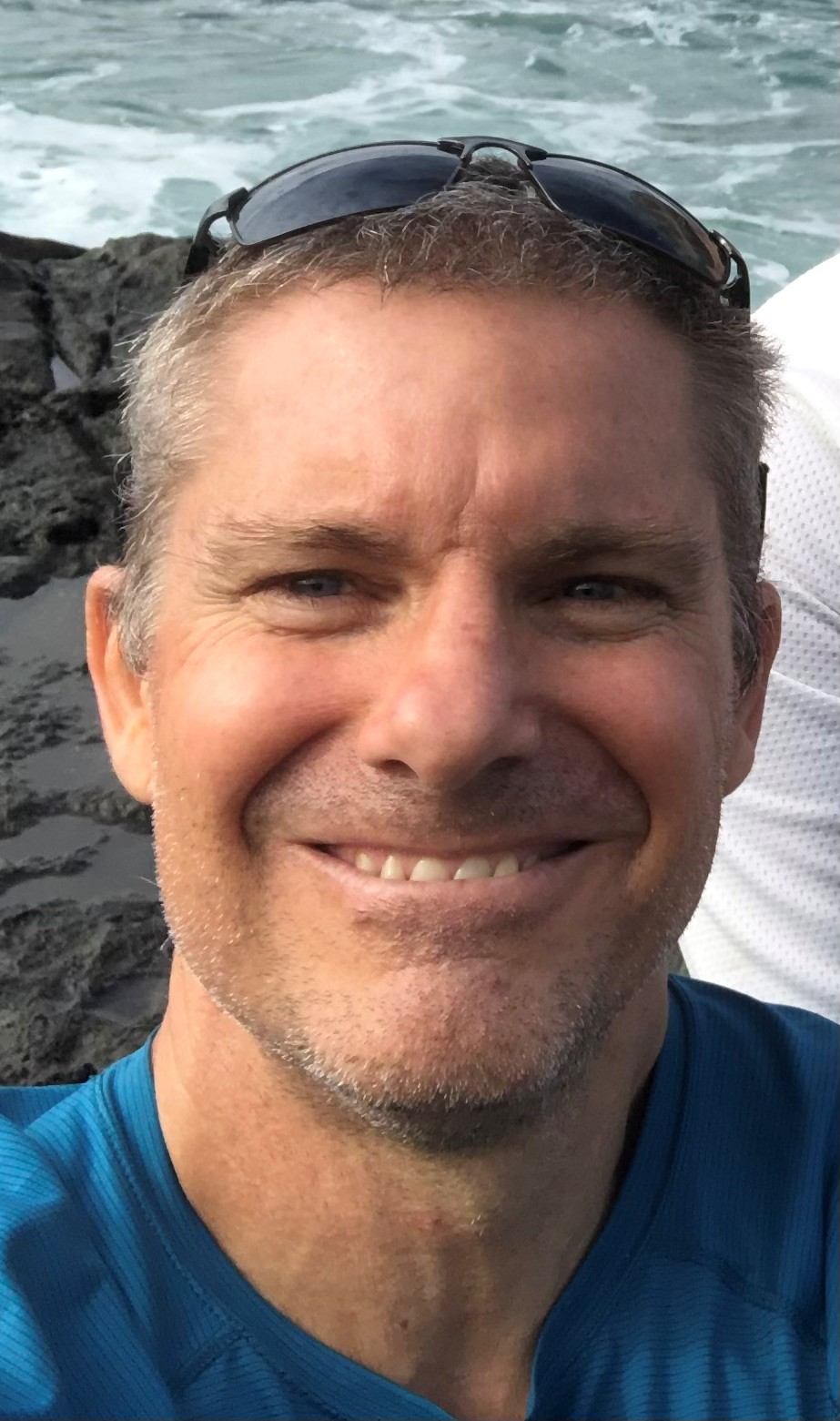
Matt McDermott is a Project Manager / Principal Investigator at Cultural Surveys Hawai‘i. Born and raised in Kailua, O‘ahu, Mr. McDermott has over 25 years of experience in archaeology and cultural resource management and has lived and worked on all but one of the major Hawaiian islands. He has detailed knowledge of Hawai‘i, Arizona, and Federal historic preservation and environmental legislation and years of experience facilitating historic preservation consultation among private clients, Native American tribes, Native Hawaiian organizations, and Federal, State, and municipal agencies. Since 2001 he has been a principle investigator with Cultural Surveys Hawai‘i and, since 2004, a project manager, overseeing a diverse range of cultural resource management projects including the Honolulu Rapid Transit project, the Ward Neighborhood Master Plan Development, the Ala Moana Center Expansion/Park Lane Development, and the Kālia-Fort DeRussy Wastewater System Improvement project. Mr. McDermott is a 2-term Board Member of the State of Hawai’i Historic Places Review Board (2015 – 2019, 2019 – 2023).

Elaine Jackson-Retondo, Ph.D. Region Preservation Partnerships and History Programs Manager, Interior Regions 8, 9, 10 and 12 in the National Park Service Pacific West Regional Office, earned her Doctorate in Architectural History and Masters of Architecture from the University of California, Berkeley and her Bachelor of Architecture from the University of Notre Dame in South Bend, Indiana. She has worked in the National Park Service since 2002.
Ms. Jackson-Retondo’s current and past work has included the National Park Service’s American Latino Heritage Initiative, Asian American Pacific Islander Initiative, Japanese American confinement during World War II, Cesar Chavez and the Farm-worker Movement, the National Park Service’s Mission 66 Program, and 19th century carceral institutional landscapes.

Kiersten Faulkner is the chief executive of Historic Hawai‘i Foundation and oversees all aspects of its preservation programs, strategic planning, business lines and operational matters. She holds a Master of Arts in Urban and Environmental Policy from Tufts University and is a member of the College of Fellows of the American Institute of Certified Planners (FAICP).


